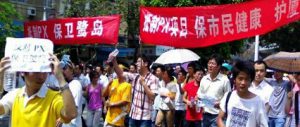China has been engrossed in the mass protests in Shifang, Sichuan province, where on the morning of July 2, locals and police clashed during demonstrations against a planned molybdenum and copper refinery. The next day, the government announced a halt to the project, restoring calm.
Events at Shifang provide the latest signal of an important trend: a widening of China’s environmental movement. No longer is green campaigning solely the work of a small elite. Ordinary people, whose interests are at stake, are also taking to the streets.
Just a few years ago, the Chinese environmental lobby comprised a coterie of enthusiastic, nature-loving pioneers. Even the landmark protests in 2004 against a string of dams on the Nu River, which would have had a huge ecological and social impact and were eventually shelved, were carried out by environmental NGOs, academics and media figures, some students and a very small number of locals.
More recently, however, concerns over chemical plants in the coastal cities of Xiamen and Dalian and – this month – in Shifang, have sparked mass protests involving 10,000 or more people. This is a marked change. Such protests involve ordinary, local people, have arisen and been resolved in very similar ways and are becoming more frequent and intense.
Although, in each case, these protests have been quickly resolved, the root problems remain. The projects that triggered them have the legally required environmental clearances, so why the political and social turmoil? Why do local governments exclude local people from the decision-making process? And why do residents resort to street protests and borderline violent methods to make their point? Why do these cases keep happening? Will these protests bring about positive reforms, or the opposite? To put it simply: what do environmental street protests mean for China?
The Shifang case reflects a crisis of local governance common in China today. In many cities, it’s the local government that wants economic development – not the locals themselves. The benefits to the community of more polluting factories are limited and unclear, while the environmental harms are very real. The so-called environmental impact assessment process is, increasingly, a mere formality, with expert assessments replacing negotiations between groups with differing interests. With interested parties excluded, local governments use the assessments to provide scientific backing for projects.
But science cannot replace democracy. Without the participation of interested parties, no conclusion – no matter how scientific or authoritative – will be convincing. Ordinary people have extremely limited opportunities to work within the system, and so the use of unconventional methods such as street protests is inevitable. The system’s inability to balance interests and allow participation generates direct confrontation.
Environmental street protests have a wider significance: they are becoming part of China’s overall social movement. In some parts of the country, there is a comprehensive crisis of local governance, expressed in the varying degrees of failure to provide justice in environmental and law-enforcement spheres. Chinese citizens have attempted to do something about this, but there are very limited channels for them to participate in politics and make their voices heard, bar social campaigning.
Environmental activism has already developed into one part of China’s expanding social movement. If the Shifang protestors had been pursuing social justice as well as environmental justice, the number of participants would have been even higher. Many of the protestors were only indirectly affected by the project, or imagined they would be affected, and there was a strong turnout by young protestors.
These street protests make direct and fixed demands. In the past, Chinese environmentalists have been criticised for choosing soft targets and moderate strategies, for being more “rational” than “tough”. The result has been that when large state-owned enterprises have been involved in environmental incidents – such as the pollution of the Songhua River in November 2005 caused by explosions at a petrochemical plant in Jilin, or the blast and oil spill in Dalian, north-east China, in the summer of 2010 – they have avoided speaking out or taking action.
But local street protests use more radical methods. In Shifang, some demonstrators broke through police lines and attacked government buildings. These are actions born of the circumstances. Few people enjoy resolving problems through violence, but other routes to participation and expression are blocked, while the system appears to allow for successful street protests. Demonstrations in Xiamen, Dalian and Shifang all produced fairly positive outcomes.
Just like the environmental movement itself, local governments’ ideas and methods for handling these incidents are as yet unformed. Stability does not mean the absence of political conflict or social movements, but the state working to bring that conflict within the system. But, regrettably, local governments often exclude interested parties from the decision-making process, and fail to communicate when conflict worsens. Often, they escalate the conflict. This is clear in the forceful methods some authorities have used to preserve stability, suppressing voices of opposition and branding opponents enemies.
One example is the way in which local governments tend to blame street protests triggered by environmental concerns on “small gangs” or “ill-informed members of the public”, acting on “ulterior motives”. These are usually false accusations which make the protestors out to be either wrongheaded, or fools who have been incited to cause trouble, and can only result in more opposition. Moreover, this approach provides the local government with an excuse to mobilise the police, which does nothing to solve the problem. Both sides use more extreme methods and the situation escalates.
With major problems in the structures and processes of local governance, there are no clear and mutually accepted rules of discussion. This was true in the cases in Xiamen, Dalian and Shifang, at all stages of the process – the initial decision-making, the growth of opposition, interaction between the public and officials, worsening conflict and the ultimate resolution.
In the end, street protests, bordering on violence, were used as a means of expression and resolution. Thankfully, there was no bloodshed in Shifang, but there are no guarantees that will be the case next time around. Before we see serious violence, before true enmity takes root, we need a fresh start for China’s social governance.
Hard decisions must be taken to reform the political system, to face up to the people’s desire for political participation, to use methods such as democratic elections to rein in local government’s untrammelled economic development. If they are not, then we face social collapse caused by pollution, the yawning wealth gap, a lack of public services and pessimism. The growth of environmental protests is a final warning. It is time for social reform.
Tang Hao is deputy professor at South China Normal University, a Fulbright scholar and a chinadialogue columnist.
Homepage image by Globalvoices shows the 2011 protest in Dalian.



